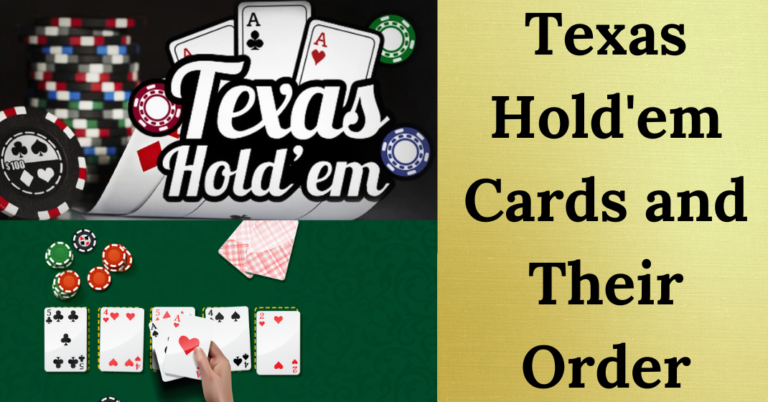How Does Each Way Betting Work (Must Know Advice & Tips)

If you are wondering how does each way betting works? Then, you are not alone. Each way (E/W) betting allows you to cover both the win and place positions with a single bet. It has evolved from mainly being used in horse racing to now being offered across various sports. This comprehensive guide will explore the world of each-way (E/W) betting. We will cover everything from how E/W betting works to advanced betting strategies across sports while emphasising responsible gambling. You will gain invaluable insights from our team of experts into calculating payouts, interpreting odds, determining value, and maximising returns on your bets with the help of relevant examples and statistics.
WHAT IS EACH WAY BETTING
Each way betting effectively splits your stake across two parts – a winning bet and a place bet:
- The win part of the bet is on your selection to win the event outright. This pays out at the full odds that you take at the time of placing the bet.
- The place part of the bet is on your selection to finish in a designated number of places, usually the top 2, 3, 4 or maybe even 5, depending on the sport and the number of entrants. This part pays out at a fraction of the full odds, usually 1⁄4, 1⁄5th or 1⁄2.
EXAMPLE:
You bet $10 E/W on a horse priced at 10/1 odds. The race pays the top 4 places at 1/5 odds.
- If the horse wins, you get $110 back ($100 for the win and $10 for the place).
- If it finishes 2nd, 3rd or 4th, you get $12 back just for the place ($2 profit).
This provides insurance if your selection fails to win but makes the frame.
Also Read: How To Play Texas Hold’em: Rules And Tips You Must Know
BASICS OF EACH WAY BETTING
Now that we know what each way betting is, let’s understand and start with the basics of each way betting to know how it works:
Components Of An Each Way Bet
As highlighted earlier, an each way bet has two components:
This is for your selection to win the event outright. The returns for this part of the bet are calculated simply by multiplying your stake with the odds you took when betting. This is the same as betting just on the outright winner market.
This is for your selection to finish in a designated number of places, usually the top 2, 3, 4 or maybe even five places, depending on the number of entrants and rules of the sport. For the place part of the bet, you get a fraction of the full odds, usually:
- 1/4 odds
- 1/5 odds
- 1/2 odds
Example:
You bet $10 E/W on a horse at 10/1 odds (the race pays the top 4 places at 1/5 odds)
- If it wins, you get $100 back for the win bet and $20 back for the place bet.
- If it finishes 2nd, you get $0 for the win but still win $20 for the place.
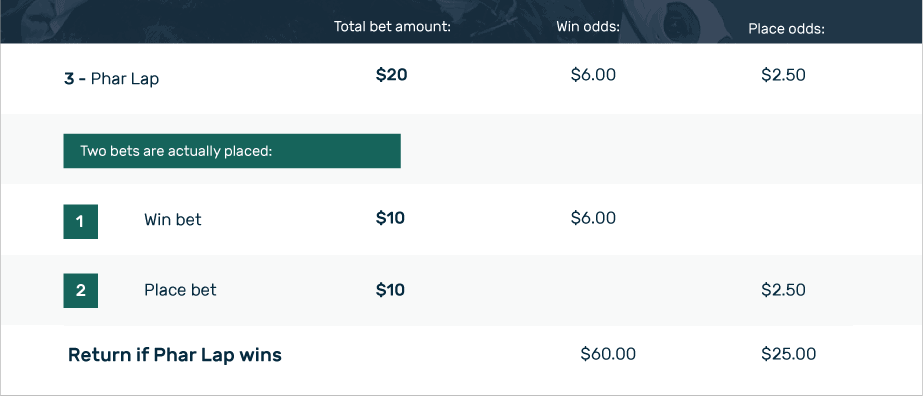
SUITABLE EVENTS
E/W betting works for any event with a large field where the favourites do not dominate. This includes:
- Horse racing – especially handicap races
- Golf tournaments
- Championship futures (winner markets) in sports like:
- Football
- Tennis
- Basketball
- Ice hockey
- Betting on top goalscorer/try scorer across a season-long league
- Special markets like award winners, TV show winners, etc.
It is not ideal for small field events where favourites have a high chance of winning, like boxing, or low-scoring sports where draws are common.
HOW EACH WAY BETTING WORKS
Now that we have covered the basics, let us go deeper into how E/W betting works when calculating payouts, interpreting odds and applying it across different sports.
CALCULATING A EACH WAY BET
An easy way to calculate your returns from an E/W bet is:
- You get your stake back.
- Plus your stake x the complete odds for the win bet
- Plus your stake x the fractional odds for the place bet
- You get your stake back.
- Plus your stake x the fractional place odds
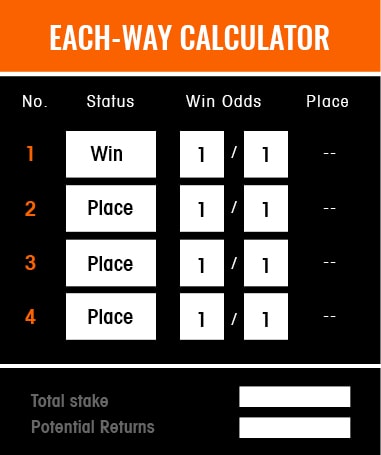
Let’s demonstrate with an example:
| Scenario | You Bet | Returns |
| $10 E/W on a horse priced at 10/1<br> (pays top 4 places @ 1/5 odds) | $20 | If it wins: $10 + ($10 x 10) + ($10 x 2) = $120<br>If it places: $10 + ($10 x 2) = $30 |
| $10 E/W on a team priced at 50/1 <br>to win the championship (pays top 2 @ 1/2 odds) | $20 | If it wins: $10 + ($10 x 50) + ($10 x 25) = $510 <br>If 2nd: $10 + ($10 x 25) = $260 |
UNDERSTANDING ODDS
It is key to note that the odds for the place part of the bet are always lower than the full odds:
Favourite – Very short-priced favourite
Outsider – High-priced longshot
The gap between the full odds and place odds is lower. This means E/W betting has better value for picks with longer odds.
Examples From Different Sports
Each way betting works slightly differently across sports. Let’s take a look at some examples:
PGA Tour events often pay around 5 E/W places at 1/5 odds. So if you bet $10 E/W on a golfer priced at 50/1:
- If he wins, you get $510 back
- If he finishes 5th, you still get $20 back
Consider also that with 156 golfers typically competing, a top 5 finish is very respectable.
Tennis Grand Slam winner markets tend to pay E/W terms for the two finalists. So if you bet $10 E/W on a underdog priced at 500/1:
- If he wins, you get a huge $5,100 back
- $250 back at 1/2 odds if reached finals.
This is an excellent hedge if a surprise finalist emerges but fails to win the title.
STRATEGY AND CONSIDERATIONS FOR EACH WAY BETTING
Now that you understand the mechanics of E/W betting, let’s dive into strategies around when and how to leverage it effectively.
When To Use E/W Betting
- You fancy an outsider who could potentially place but is unlikely to win
- E.g. Betting on a golfer to finish top 5 at a Major
- The favourite looks too short to provide value to win outright
- E.g. betting on Nadal to win French Open
- There is a standout favourite who is likely to win
- E.g. betting on a favourite racehorse in a small field
- You want to cover multiple outcomes with a single bet
- E.g. betting on a team to win the league or finish 2nd
Analysing Risk Vs. Reward
The main benefit of E/W betting is it caps your downside risk while providing upside if your pick wins. You should analyse:
- The chance your selection has to win realistically
- The chance it has to at least place
- The optimal ratio between your profit if it wins vs places
As a rule of thumb, you want to lose as little as possible if it places and still makes a decent profit if it wins. If the place loss is too high, consider betting only on that market.
Impact Of Field Size
The number of entrants/competitors significantly impacts the ideal E/W strategy. Some of the things to consider are:
- Even a top 5/10 finish is commendable for an underdog in large fields like golf tournaments.
- In small fields, the place bracket is narrow, so it may not offer enough value.
- Be aware of competitions where several entrants tie for a place – this could dilute winnings.
EACH WAY BETTING IN HORSE RACING
Now, let’s zero in on horse racing – where the concept originated over 200 years ago – and key nuances punters must consider.
Specifics In Horse Racing
In horse racing, E/W betting terms are standardised based on field size:
| Runners | Minimum E/W Places |
| 2-4 | No places |
| 5-7 | 2 places |
| 8-15 | 3 places |
| 16+ | 4 places |
The fraction of odds offered varies by race type but is commonly -1/5 and 1/4. There are also additional “rule 4” deductions to account for if horses are withdrawn close to the start of the race.
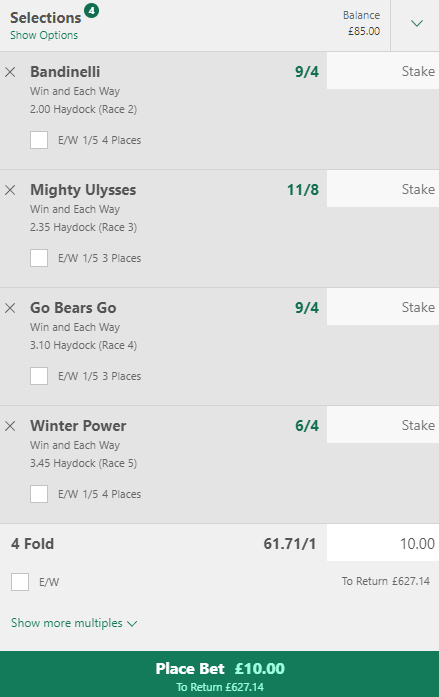
Also Read: How To Play Poker Without Chips (7 Unique And Fun Ways)
HOW PLACE TERMS ARE SET
In horse racing, each way rules, the number of spots paying out is mathematically determined based on field size rather than fixed or arbitrary by sportsbooks. Michael Harris, a betting trading veteran, explains:
“Since favourites win 35-40% of races regardless of runners, to balance books, everyone agrees to pay extra places and reduce place odds in larger fields.”
So if a field size doubles from 8 to 16 runners – the probability of picking a winner halves – so the bookmakers double the number of E/W spots from 3 to 4 to compensate punters and balance their risk.
KEY HORSE RACING EVENTS
The most popular global horse races for E/W betting based on average field size include:
- The Grand National (40 runners)
- The Kentucky Derby (20 runners)
- Melbourne Cup (24 runners)
- Epsom Derby (12-20 runners)
Many tracks like Ascot regularly schedule large handicap races with 16+ runners suitable for E/W punting. In these races with huge fields, finishing in the frame is a respectable performance for long shots.
EACH WAY BETTING IN GOLF
Let’s consider key things when E/W betting on golf tournaments.
While golf E/W terms vary a bit by sportsbook and tournament, there are some commonalities:
- Payout is usually in the top 5 places.
- The fraction of odds is 1/5th
So if you bet $10 E/W on a golfer priced at 100/1:
- If he wins, you get $10 + ($10 x 100) + ($10 x 20) = $1,120
- If he finishes 5th, you get $10 + ($10 x 20) = $210
For prestigious Majors like The Masters or US Open, the standard each-way terms usually apply given large fields of around 90-100 golfers. Some additional considerations for golf E/W betting:
- Remember that 1-2 stroke leads can quickly diminish over 18 holes.
- Account for golfers with a tendency to frequently finish in the top 5 vs actually winning
- Back golfers are suited to course terrain, conditions, and holes.
An interesting point to note is that golf E/W places are not mathematically pre-determined based on field size, unlike horse racing. 5 seems to be the accepted convention used over time. Golf trading veteran Steve Palmer notes:
“Standard each-way terms of 1/5 odds 1,2,3,4,5 ensures books are balanced. Top 5 is around 12% of the field, so it seems fair.”
EACH WAY BETTING CASE STUDIES
Let’s explore some real-world examples of how E/W betting is applied across different sports:
Football – In the 2022 World Cup, Morocco went on a stunning giant-killing run. Punters who had backed them pre-tournament at 500/1 each way were ecstatic as their bet cashed out superbly for Morocco to reach the semi-finals and finish overall 4th.
Tennis – Emma Raducanu stunned the tennis world by winning the 2021 US Open as a qualifier, ranked 150th in the world pre-tournament. Punters who had placed each way bets on her at 300 or 500/1 to win the title or at least reach the final were handsomely rewarded.
Golf – In the 150+ golfer 2021 Open Championship, many punters backed rank outsiders to finish in the top 5 each way at long odds for some rather than try to predict the winner. These bets cashed out well thanks to players finishing high up the leaderboard.
LEGAL AND RESPONSIBLE GAMBLING CONSIDERATIONS
While we have covered multiple strategies, you must bet responsibly and be aware of gambling regulations in your region.
IS EACH WAY BETTING LEGAL?
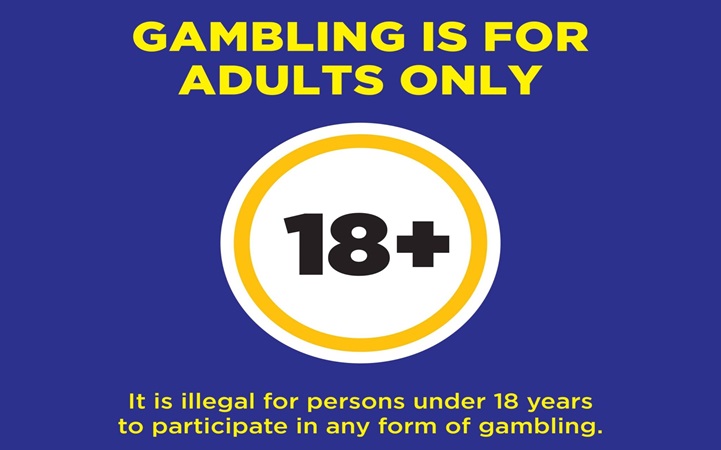
Either way, betting is legal in most countries. However, given complex regulations, it’s essential you:
- Check your local gambling laws before wagering.
- Only bet with licensed operators in legal markets
- Avoid unregulated bookmakers and jurisdictions.
- Set a clear budget for total stakes.
- Take a long-term view of profitability.
- Avoid chasing losses with rash bets.
- Remember the recreational enjoyment aspect.
If you feel you may be developing an unhealthy addiction, please reach out to resources like Gambler’s Anonymous and GamCare for help.
EACH WAY BETTING FAQ’s
1) Can I place E/W bets as the event progresses?
Yes. Many books allow live E/W betting. But the odds will be lower than pre-event.
2) What happens if a place picks ties with others?
Winnings are calculated as if the bet placed was divided by several placers.
3) Can I choose how many E/W places I want?
Some books allow flexibility, but otherwise, standard place terms apply.
4) Is E/W betting profitable long term?
Used judiciously on value bets, it can boost win percentages and returns.
5) How do I calculate returns on E/W accumulator bets?
Break down each selection into parts to understand total liability and payouts.
FINAL VERDICT
This comprehensive guide has equipped you with invaluable insights into the world of each way betting, including calculating payouts, interpreting odds, determining value, and maximising returns across sports. Used responsibly with a structured, analytical approach, each way betting can boost your chances of success. Follow these tips responsibly with a long-term, value-based betting mindset to maximise your chances of success.




